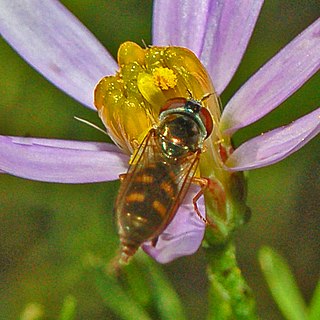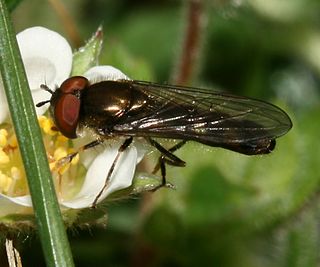
Syrphus ribesii is a very common Holarctic species of hoverfly. Its larvae feed on aphids. In common with many other species of hoverfly, males have the eyes meeting on the top of the head, whilst females have their eyes widely separated.

Platycheirus clypeatus is a species of hoverfly. It is found across the Palearctic and in the Nearctic. The larvae feed on aphids. Adults are usually found on the edges of woodland or scrub, heath or along hedgerows where they visit a wide range of flowers.

Platycheirus peltatus is a Palearctic species of hoverfly.

Meliscaeva cinctella is a Holarctic species of hoverfly.

Platycheirus scutatus is a very common species of hoverfly. It is a Holarctic species.

Platycheirus albimanus is a common widespread species of hoverfly. A holarctic species its range includes Greenland, Iceland, Britain, mainland Europe, Russia, across Siberia to the pacific coast, the Philippines, Alaska, western Canada and United States.

Platycheirus fulviventris is a Palearctic species of hoverfly. It is found in many parts of Britain and Europe.

Platycheirus granditarsus, the Hornhand Sedgesitter, is a species of hoverfly. It is found in many parts of Britain North America and Europe. Typical habitat includes marshy meadows and ditches, where it can be found between May and October, though it is at its commonest between July and September. The most distinctive feature of this fly is the red-orange abdomen most easily seen as it takes off or alights.

Platycheirus manicatus is a species of hoverfly. It is found across the Palearctic and in Alaska.

Platycheirus rosarum is a species of hoverfly found in the Palearctic. Like its close relative Platycheirus granditarsus, it can be found in marshy meadows and ditches; indeed, the two species can often be found together. The flight time is between May and October, though it peaks in abundance in June and July.

Syrphus vitripennis is a very common European and North American species of hoverfly. Its larvae feed on aphids

Platycheirus ambiguus is a small widespread species of hoverfly found across the Palearctic from Ireland to Japan. A spring species found in flight in April and May, it visits spring-flowering trees and shrubs, e.g., Prunus spinosa in deciduous woodland and scrub.
Platycheirus amplus is a Holarctic species of hoverfly found in wetlands, fens, moorland streams and bogs.

Platycheirus angustatus is a species of hoverfly. It is found in many parts of the Palearctic, and in the Nearctic.
Platycheirus perpallidus is a species of hoverfly. It is a Holarctic species.
Platycheirus podagratus is a species of hoverfly. It is found in the Holarctic.

Paragus haemorrhous, the Black-backed Grass Skimmer is a common widespread species of hoverfly found in many parts of Europe, Africa and the Nearctic. Hoverflies can remain nearly motionless in flight. The adults are also known as flower flies for they are commonly found on flowers from which they get both energy-giving nectar and protein-rich pollen. The larvae are predators on aphids.

Meligramma guttatum is a Holarctic species of hoverfly.

Didea alneti is a Holarctic species of hoverfly.

Epistrophe nitidicollis is a European and North American species of hoverfly.


















